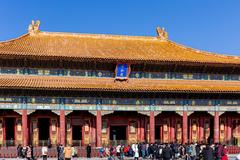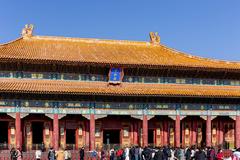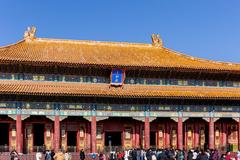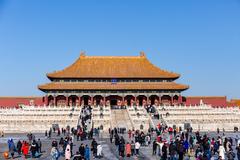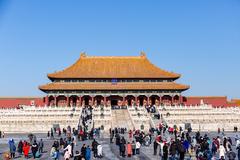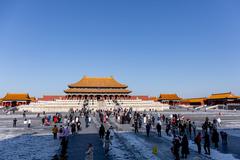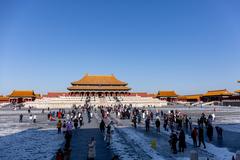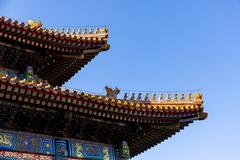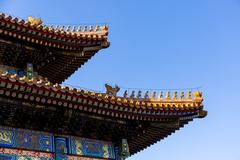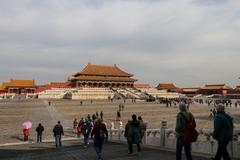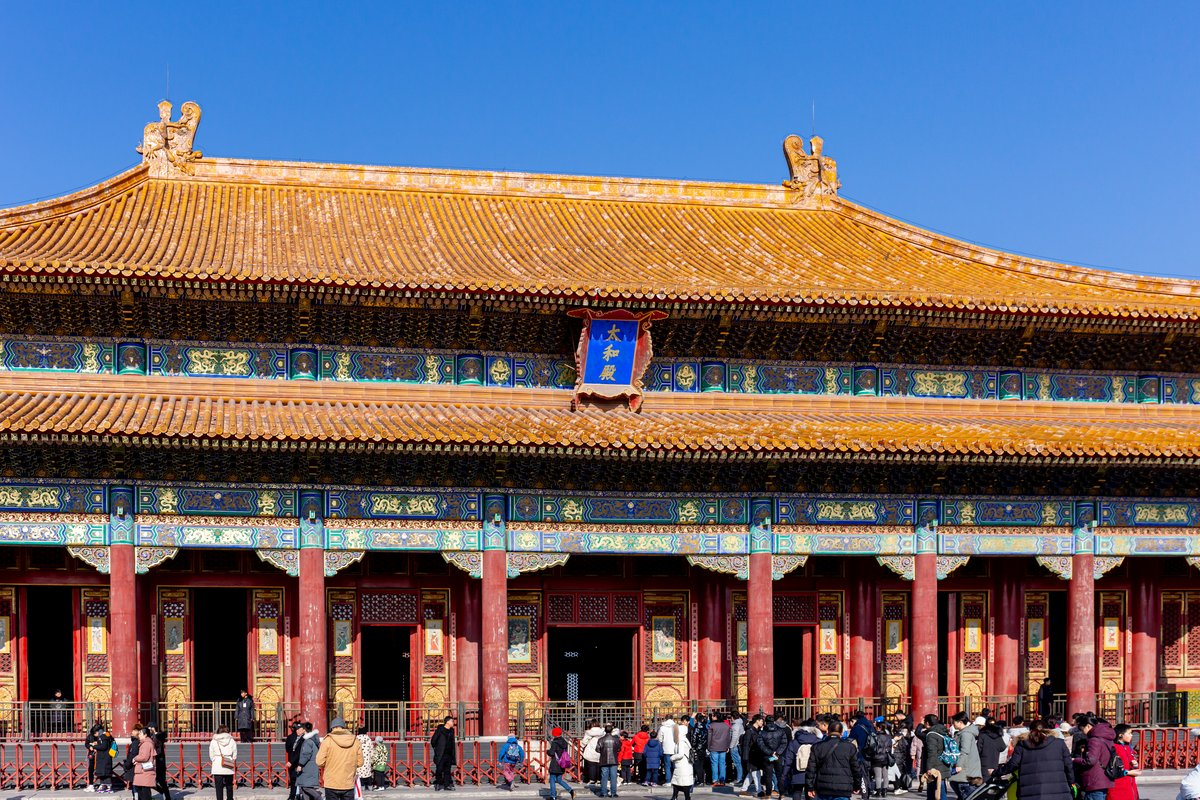
Hall of Supreme Harmony: Visiting Hours, Tickets, and Comprehensive Guide to Beijing’s Imperial Landmark
Date: 14/06/2025
Introduction
The Hall of Supreme Harmony (Taihe Dian, 太和殿), at the heart of Beijing’s Forbidden City, stands as the largest wooden structure in China and a symbol of imperial power, cosmic order, and architectural mastery. Once reserved for the most important state ceremonies of the Ming and Qing dynasties, its golden roof, intricate dragon motifs, and imposing marble terraces have witnessed centuries of Chinese history. Today, the hall draws millions of visitors, offering not only an unparalleled glimpse into China’s imperial past but also a showcase of traditional architectural brilliance.
This definitive guide provides essential information for planning your visit—including historical context, architectural highlights, visiting hours, ticketing, accessibility details, travel tips, and nearby attractions. Whether you are a history aficionado, architecture enthusiast, or curious traveler, this article will help ensure a meaningful and memorable experience at one of Beijing’s most iconic historical sites.
Contents
- Introduction
- Historical Overview
- Construction and Dynastic Significance
- Renaming and Symbolism
- Restoration and Preservation
- Architectural Features and Symbolism
- Ceremonial Functions and Imperial Rituals
- Visiting Information
- Hours and Ticketing
- Accessibility and Visitor Flow
- Travel Tips and Best Times to Visit
- Nearby Attractions
- Visual and Interactive Resources
- Frequently Asked Questions (FAQ)
- Conclusion and Practical Summary
- Sources
Historical Overview
Construction and Dynastic Significance
Commissioned by the Yongle Emperor in the early 15th century, the Hall of Supreme Harmony was completed in 1420, serving as the ceremonial heart of the Forbidden City. Though several fires necessitated reconstructions, its essential role in imperial governance never changed. Throughout the Ming and Qing dynasties, the hall represented the axis of both the physical palace and the imperial power structure, where emperors celebrated enthronements, weddings, military victories, and New Year ceremonies (Lonely Planet).
Renaming and Symbolism
Originally named Fengtian Dian (“Hall of Heavenly Mandate”), it was later called Huangji Dian (“Hall of Imperial Supremacy”) before being restored to its present name, Taihe Dian (“Hall of Supreme Harmony”). The evolution of its name mirrors the shifting philosophies and political priorities of successive dynasties, always centering on the emperor’s divine right and the Confucian concept of harmony (MyBeijingChina).
Restoration and Preservation
The current hall largely dates from 1695, rebuilt after a devastating fire under the Kangxi Emperor. It has undergone careful restorations, preserving its traditional timber-frame construction, intricate joinery, and symbolic decorations. These efforts ensure that modern visitors experience the hall much as it was centuries ago (East China Trip).
Architectural Features and Symbolism
Layout and Structure
- Central Axis Placement: The hall sits atop a three-tiered white marble terrace on the Forbidden City’s central north-south axis, epitomizing the hierarchy and symmetry fundamental to Chinese palace design.
- Dimensions: Measuring 63.96 meters wide, 37.2 meters deep, and standing 35.05 meters high, it is the largest extant wooden structure in China (East China Trip).
- Roof and Ornaments: The double-eaved roof is covered with yellow glazed tiles—the imperial color—and features ten mythical beasts, a privilege reserved only for the most important building. These statuettes, including dragons and phoenixes, were believed to ward off evil and signify the building’s supreme status (Asian Studies).
- Pillars and Materials: Seventy-two massive wooden columns support the vast hall. The flooring consists of “golden bricks” renowned for their strength and golden hue.
Decorative and Symbolic Elements
- Dragon Motifs: Dragons, symbols of imperial power and auspiciousness, are intricately carved throughout the hall, including the throne, ceilings, and balustrades (MyBeijingChina).
- Color and Material Symbolism: Yellow symbolizes centrality and sovereignty; red denotes good fortune; white marble conveys purity and strength (North45et).
- Numerology: The use of the number nine (as in the nine steps of the marble terrace) reflects the highest yang number, symbolizing the supreme position of the emperor (Asian Studies).
Engineering Techniques
Traditional Chinese timber-frame construction is used throughout, employing interlocking brackets (“dougong”) for both flexibility and earthquake resistance. The hall’s marble terraces are defensive and ceremonial, designed to elevate and protect the emperor (Asia Odyssey Travel).
Ceremonial Functions and Imperial Rituals
The Hall of Supreme Harmony was the exclusive stage for the grandest imperial ceremonies:
- Enthronement and Coronations: New emperors accepted the Mandate of Heaven here.
- New Year and Birthday Celebrations: Annual ceremonies reinforced cosmic order and imperial legitimacy.
- Military Victories and Foreign Envoys: The emperor received tributes and issued edicts, reinforcing the hierarchy.
- Social Hierarchy: Only select officials could approach the central path; all others displayed their fealty through ritual prostration (Lonely Planet).
Visiting Information
Hours
- April–October: 8:30 AM – 5:00 PM (Last entry at 4:00 PM)
- November–March: 8:30 AM – 4:30 PM (Last entry at 3:30 PM)
- Closed on Mondays, except for public holidays (Palace Museum website).
Tickets
- Standard Admission: ~60 CNY (April–October), ~40 CNY (November–March)
- Discounts: Available for students, seniors, and children (with ID)
- Purchase: Tickets must be purchased online in advance through the official Palace Museum website or authorized platforms. On-site ticket sales are very limited or unavailable. Be aware that daily visitor numbers are capped (around 80,000), so early booking is essential (Travel of China).
- Entry: Passport or Chinese ID required for ticket booking and entry.
Accessibility and Visitor Flow
- Wheelchair Access: Ramps and accessible routes are available along the central visitor pathway, including marble terraces. Some historic areas have steps and uneven paving; visitors with mobility needs should contact the museum in advance for guidance.
- Visitor Flow: The site follows a one-way route from the Meridian Gate, through the Outer Court, past the Hall of Supreme Harmony, and onward to the Inner Court and Imperial Garden.
Travel Tips and Best Times to Visit
- Arrive Early: To avoid crowds, especially during weekends and public holidays.
- Best Seasons: Spring (March–May) and autumn (September–November) offer mild weather and fewer visitors.
- Summer: Hot and crowded; bring water, sun protection, and be prepared for long walks.
- Winter: Quieter but cold, with shorter daylight hours.
- Comfort: Wear comfortable shoes; the complex covers over 180 acres.
- Guided Tours: Multilingual audio guides and English-language guided tours are available and highly recommended for a deeper understanding of the site.
- Photography: Allowed in most outdoor areas; flash and tripods are not permitted inside the halls.
Nearby Attractions
- Imperial Garden: Located at the northern end of the Forbidden City, offering tranquil landscapes and traditional pavilions.
- Jingshan Park: Directly north of the Forbidden City, providing panoramic views of the palace complex and Beijing skyline.
- Tiananmen Square: Just south of the Forbidden City, a focal point of modern Chinese history.
- Palace Museum Exhibitions: Explore additional galleries for art, artifacts, and special exhibitions.
Visual and Interactive Resources
- Virtual Tours: Online virtual tours offer interactive exploration of the hall’s architecture and historical artifacts (Palace Museum website).
- Onsite Maps and Signage: Clear signage and maps in multiple languages guide visitors through the complex.
- Image Suggestions: Seek high-resolution photographs of the hall’s golden roof, marble terraces, and dragon throne. Alt-tags should include descriptive keywords such as “Hall of Supreme Harmony Beijing” and “Imperial architecture Forbidden City.”
Frequently Asked Questions (FAQ)
Q: What are the Hall of Supreme Harmony visiting hours?
A: Open 8:30 AM–5:00 PM (April–October) and 8:30 AM–4:30 PM (November–March), closed Mondays except holidays.
Q: How do I buy tickets?
A: Tickets must be purchased online in advance via the official Palace Museum website or authorized platforms.
Q: Is the Hall of Supreme Harmony wheelchair accessible?
A: Main routes are accessible; some historic sections have steps. Contact the museum for assistance.
Q: Are guided tours available?
A: Yes, English-language tours and multilingual audio guides are offered.
Q: Can I take photos?
A: Photography is allowed in outdoor areas; inside halls, flash and tripods are prohibited.
Q: What nearby sites should I visit?
A: Don’t miss the Imperial Garden, Jingshan Park, and Tiananmen Square.
Conclusion and Practical Summary
The Hall of Supreme Harmony is not just a building—it’s a living testament to China’s imperial past, architectural grandeur, and deep-rooted cultural symbolism. With its origins stretching back to the Ming Dynasty and continuous reconstructions reflecting the dynastic narratives, the hall remains central to understanding Beijing’s—and indeed, China’s—imperial legacy. By planning your visit with up-to-date information on hours, ticketing, and accessibility, you can immerse yourself in history while enjoying a smooth and enriching experience.
For more personalized guidance, guided tours, and real-time updates, download the Audiala app and follow our channels for insights into Beijing’s historical wonders.
